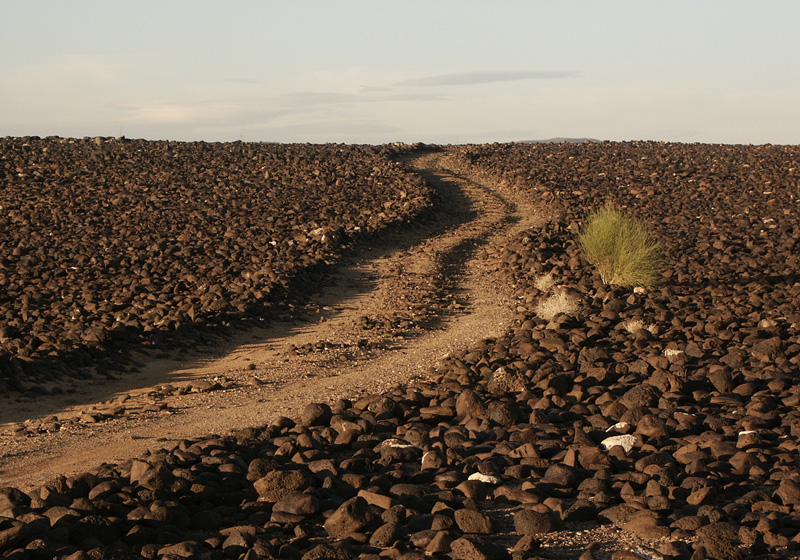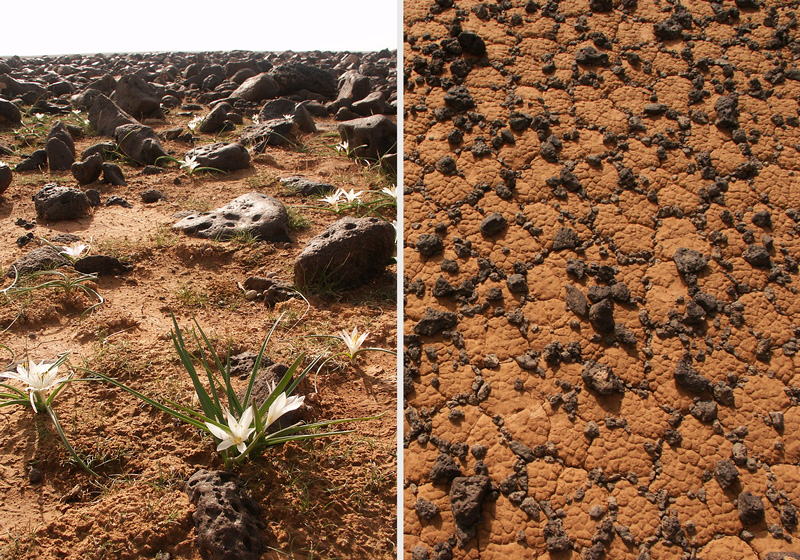Basalt Bombs
A day in the black basalt desert is a life experience. Black is beautiful. There, you can see better, as if through some very advanced sunglasses not invented yet, basalt absorbs most of the desert glare and only sends to your eyes delicately selected rays of the deepest colors of nature.

About one sixth of Jordan is covered with volcano-spillage; the hardened lava that we call basalt. Most of it can be seen at the continuous "Basalt Plateau" between Mafraq, Azraq and the northern borders with Syria. This is part of the larger volcanic formation of "Harret Al Sham", a central and substantial part. The rest of "Harret Al Sham" which covers most of southern Syria, starting at Damascus, runs southeast as a strip -100 km wide- passing in Jordan and continuing for some 200 km into Saudi Arabia. Besides Harret Al Sham, Jordan has many other disconnected volcanic centers and fissures, such as Jabal Unaiza to the northwest of Ma'an, volcanoes around Tafileh, Makawir Ma'in region, and many others. In total, at least some 40 volcanic centers and fissures can be easily found scattered in the desert to the north and east of Azraq and on the eastern bank of the Rift Valley between Petra and the northern tip of the Dead Sea.
"Volcanology" is interesting. It involves understanding the destructive, yet beautiful, powers of nature, and, in Jordan, it is about discovering the fossilized results of such creative acts. Early humans might have seen, in action, some of the youngest volcanoes in Jordan. Such volcanoes were active as recent as 1.5 million years ago, and even 0.5 million years. While the older ones date back to as much as 18 million years, way before humans walked this land. To those who have seen, the smaller and younger volcanoes would have performed a brilliant light show.
As fountains of fire, these volcanoes threw lumps of viscous (partially-molten) lava high in the air, lava that the earth brought up from its inner eternal furnace. In a spectacular light and sound show, angry volcanoes vomited and spitted gases, smoke, and lumps of molten rock with temperatures more than 1000 centigrade. As these lumps were in mid flight, above the violent nozzle of the volcano, they would harden and take different shapes reflecting their motion in mid air, and land as objects with aerodynamic geometry. Like a crazy glassmaker, throwing in the sky molten glass from his kiln, each volcano's disastrous behavior was recorded in the pileup of deposits that formed its hill.
In some volcanoes, impressive, rhythmically arranged levels of volcanic bombs, suggest intermittent eruptions, resulting from a show in which every pulse started with prelude of smaller bombs –apple size- and built up a climax of bombs as large as half a meter, from allegro non troppo to forte fortissimo, now silently dormant in this three-dimensional black record.

Volcanic bombs come in beautiful colors, their crust would range from black to dark red, their inner core is often of lighter, hard, foam-like stone, with many air bubbles, and in colors ranging from pink to deep-red, violet or dark blue, and sometimes even spotted with shiny gold. Volcano ballistic bombs also come in different shapes, from round, to spindle with twisted ends, to "cow dung" bombs, to bread crust bombs and ribbon bombs. But all this natural Jordanian "bomb-menu" is now safe to children, as Mother Nature was never that evil as to coat them with depleted uranium.
The best destination for volcano visiting is the northeastern region of Jordan, the land northeast of the line between Mafraq and Azraq. For an intact volcano site you can visit Jabal Aritayn, visible from Azraq, 30 km north, as a double-tipped rust-red mountain. You can reach it by driving on the road to Iraq for 20 km after Azraq, and then turn left, northward on dirt road leading to it. This one requires a 4x4. For a dissected volcano, your best bet would be the small volcano of Tell Hassan, now half dug up as a quarry. Here you can see an impressive cross-section of the hill exposing the volcanic vents. This one is easy to reach, after droving for 15 km on the road to Iraq, it is only few hundred meters to the south of the highway, appearing from a distance as a flat-top black hill, no 4x4 is needed for tell Hassan. You can also visit the volcano quarry just north of Makawir; this one also displays good sections and plenty of volcanic bombs. Caution should be taken, especially if location has any quarrying activities, for such intervention creates unstable, sharp, and unexpected cliffs.